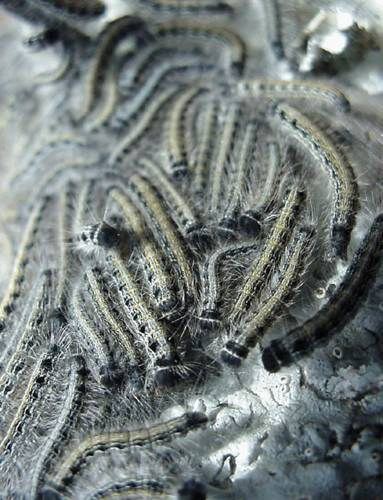
All photos © Hilton Pond Center
March Madness:
The Attack of the Tent Caterpillars
Most mammals--including humans--delight in the taste of freshly-picked wild cherries. Such tasty fruits are consumed by everything from 'possums to 'coons to foxes, but cherry trees also provide food for a number of animals that don't even eat their fruit. Here at Hilton Pond Center, for example, the fresh spring leaves of Black Cherry, Prunus serotina, are an ample nutritional source for the local horde of Eastern Tent Caterpillars, Malacasoma americana.
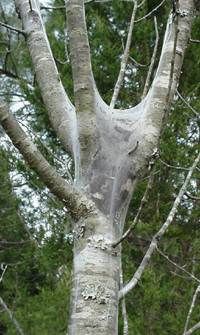 In late March--a time known throughout the Piedmont as "March Madness"--Tent Caterpillars (above) are one of the first noticeably active insects. Almost overnight, they construct small white bags in crotches of cherry trees (right)--just as tender leaves burst from bud. Each bag resembles a densely woven spider web and is the cooperative effort of silk-spinning larvae of Tent Caterpillar moths. In late March--a time known throughout the Piedmont as "March Madness"--Tent Caterpillars (above) are one of the first noticeably active insects. Almost overnight, they construct small white bags in crotches of cherry trees (right)--just as tender leaves burst from bud. Each bag resembles a densely woven spider web and is the cooperative effort of silk-spinning larvae of Tent Caterpillar moths.
Up to 300 tiny caterpillars hatch in early spring from a shiny, mahogany-colored egg case laid the summer before, often on a cherry or apple twig. The case is made of a hard foamy material that protects the eggs from winter rains and most potential predators. When Tent Caterpillars hatch out, they are scarcely an eighth of an inch long, and it takes a lot of them to spin a communal web from silk glands near their mouths.
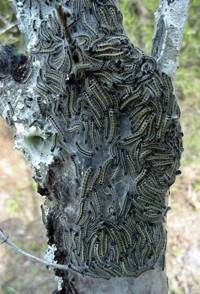 Each caterpillar from a given egg case somehow meets its siblings at a strategic crotch and cooperates in constructing the first small tent. Over the next month or so, the colony may enlarge the residence many times, weaving new tent layers over old as larvae grow larger. Here at Hilton Pond Center, we've seen an entire colony gather outside the tent in a writhing mass on the sunny side of the trunk; the function of this behavior is not clear (see photo at left). The caterpillars eat almost constantly in daylight hours and molt five times within a few weeks, eventually attaining a length of about two inches. Some of their plentiful droppings (called "frass") and old skins are buried beneath new tent layers and appear as a mass of dark granules (see photo upper right). Each caterpillar from a given egg case somehow meets its siblings at a strategic crotch and cooperates in constructing the first small tent. Over the next month or so, the colony may enlarge the residence many times, weaving new tent layers over old as larvae grow larger. Here at Hilton Pond Center, we've seen an entire colony gather outside the tent in a writhing mass on the sunny side of the trunk; the function of this behavior is not clear (see photo at left). The caterpillars eat almost constantly in daylight hours and molt five times within a few weeks, eventually attaining a length of about two inches. Some of their plentiful droppings (called "frass") and old skins are buried beneath new tent layers and appear as a mass of dark granules (see photo upper right).
A Tent Caterpillar is typically greenish with two yellow or tan stripes that run the length of a body sparsely covered with long whitish hairs (see photo below right); these aparently make the larvae unpalatable to most bird predators, but Yellow-billed Cuckoos and Blue Jays gorge on Tent Caterpillars.
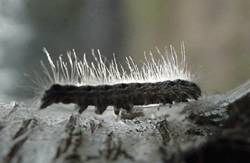 As a caterpillar colony strips a cherry tree of its leaves, the larvae often wander in search of a better food source--leaving silken trails that lead them back to the tent. Eventually, the larvae disband and each seeks out a spot in which to form its individual pupa. The caterpillar spins a tough cocoon (below left), often containing a powdery yellow substance that comes off on contact--a good field diagnostic for Tent Caterpillar cocoons. As a caterpillar colony strips a cherry tree of its leaves, the larvae often wander in search of a better food source--leaving silken trails that lead them back to the tent. Eventually, the larvae disband and each seeks out a spot in which to form its individual pupa. The caterpillar spins a tough cocoon (below left), often containing a powdery yellow substance that comes off on contact--a good field diagnostic for Tent Caterpillar cocoons.
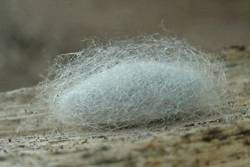 After spending two months as cocoon-covered pupae, Tent Caterpillars emerge as adults--small, tan moths with one-inch wingspans and thin white wing bands; by mid-summer at Hilton Pond Center we see these moths flying around porch lights. After mating, the female moths deposit their egg cases on cherry twigs, and all the adults die. By then, the healthiest trees will have overcome tent caterpillar gluttony by sprouting new buds and leaves, but trees under stress or ravaged by disease may be unable to summon enough reserves to grow that all-important second set of foliage. When this happens, of course, the cherry tree dies--victim to the attack of voracious Tent Caterpillars during "March Madness" at Hilton Pond Center. After spending two months as cocoon-covered pupae, Tent Caterpillars emerge as adults--small, tan moths with one-inch wingspans and thin white wing bands; by mid-summer at Hilton Pond Center we see these moths flying around porch lights. After mating, the female moths deposit their egg cases on cherry twigs, and all the adults die. By then, the healthiest trees will have overcome tent caterpillar gluttony by sprouting new buds and leaves, but trees under stress or ravaged by disease may be unable to summon enough reserves to grow that all-important second set of foliage. When this happens, of course, the cherry tree dies--victim to the attack of voracious Tent Caterpillars during "March Madness" at Hilton Pond Center.
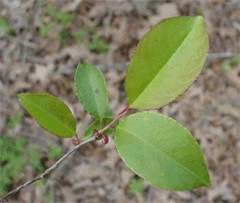 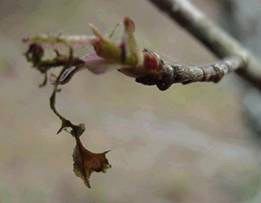
Above are authentic, unretouched photos of the incredible impact
made by a herd of Tent Caterpillars on Black Cherry leaves.
No cherry tree is safe from the voracious appetites of
these colonial creatures during "March Madness."
All photos © Hilton Pond Center
If you enjoy "This Week at Hilton Pond," please help Support
Hilton Pond Center for Piedmont Natural History
|




 In late March--a time known throughout the Piedmont as "March Madness"--Tent Caterpillars (above) are one of the first noticeably active insects. Almost overnight, they construct small white bags in crotches of cherry trees (right)--just as tender leaves burst from bud. Each bag resembles a densely woven spider web and is the cooperative effort of silk-spinning larvae of Tent Caterpillar moths.
In late March--a time known throughout the Piedmont as "March Madness"--Tent Caterpillars (above) are one of the first noticeably active insects. Almost overnight, they construct small white bags in crotches of cherry trees (right)--just as tender leaves burst from bud. Each bag resembles a densely woven spider web and is the cooperative effort of silk-spinning larvae of Tent Caterpillar moths. Each caterpillar from a given egg case somehow meets its siblings at a strategic crotch and cooperates in constructing the first small tent. Over the next month or so, the colony may enlarge the residence many times, weaving new tent layers over old as larvae grow larger. Here at Hilton Pond Center, we've seen an entire colony gather outside the tent in a writhing mass on the sunny side of the trunk; the function of this behavior is not clear (see photo at left). The caterpillars eat almost constantly in daylight hours and molt five times within a few weeks, eventually attaining a length of about two inches. Some of their plentiful droppings (called "frass") and old skins are buried beneath new tent layers and appear as a mass of dark granules (see photo upper right).
Each caterpillar from a given egg case somehow meets its siblings at a strategic crotch and cooperates in constructing the first small tent. Over the next month or so, the colony may enlarge the residence many times, weaving new tent layers over old as larvae grow larger. Here at Hilton Pond Center, we've seen an entire colony gather outside the tent in a writhing mass on the sunny side of the trunk; the function of this behavior is not clear (see photo at left). The caterpillars eat almost constantly in daylight hours and molt five times within a few weeks, eventually attaining a length of about two inches. Some of their plentiful droppings (called "frass") and old skins are buried beneath new tent layers and appear as a mass of dark granules (see photo upper right). As a caterpillar colony strips a cherry tree of its leaves, the larvae often wander in search of a better food source--leaving silken trails that lead them back to the tent. Eventually, the larvae disband and each seeks out a spot in which to form its individual pupa. The caterpillar spins a tough cocoon (below left), often containing a powdery yellow substance that comes off on contact--a good field diagnostic for Tent Caterpillar cocoons.
As a caterpillar colony strips a cherry tree of its leaves, the larvae often wander in search of a better food source--leaving silken trails that lead them back to the tent. Eventually, the larvae disband and each seeks out a spot in which to form its individual pupa. The caterpillar spins a tough cocoon (below left), often containing a powdery yellow substance that comes off on contact--a good field diagnostic for Tent Caterpillar cocoons. After spending two months as cocoon-covered pupae, Tent Caterpillars emerge as adults--small, tan moths with one-inch wingspans and thin white wing bands; by mid-summer at Hilton Pond Center we see these moths flying around porch lights. After mating, the female moths deposit their egg cases on cherry twigs, and all the adults die. By then, the healthiest trees will have overcome tent caterpillar gluttony by sprouting new buds and leaves, but trees under stress or ravaged by disease may be unable to summon enough reserves to grow that all-important second set of foliage. When this happens, of course, the cherry tree dies--victim to the attack of voracious Tent Caterpillars during "March Madness" at Hilton Pond Center.
After spending two months as cocoon-covered pupae, Tent Caterpillars emerge as adults--small, tan moths with one-inch wingspans and thin white wing bands; by mid-summer at Hilton Pond Center we see these moths flying around porch lights. After mating, the female moths deposit their egg cases on cherry twigs, and all the adults die. By then, the healthiest trees will have overcome tent caterpillar gluttony by sprouting new buds and leaves, but trees under stress or ravaged by disease may be unable to summon enough reserves to grow that all-important second set of foliage. When this happens, of course, the cherry tree dies--victim to the attack of voracious Tent Caterpillars during "March Madness" at Hilton Pond Center.
